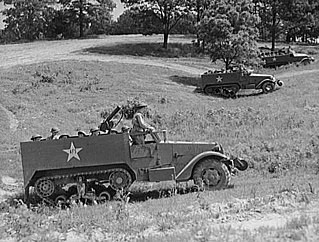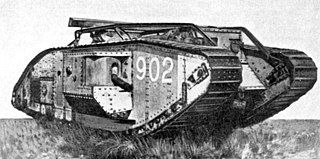
An armoured fighting vehicle (AFV) is an armed combat vehicle protected by armour, generally combining operational mobility with offensive and defensive capabilities. AFVs can be wheeled or tracked. Main battle tanks, armoured cars, armoured self-propelled guns, and armoured personnel carriers are all examples of AFVs.
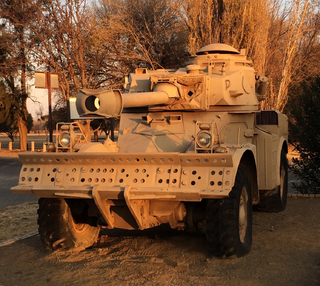
A military armoredcar is a lightweight wheeled armored fighting vehicle, historically employed for reconnaissance, internal security, armed escort, and other subordinate battlefield tasks. With the gradual decline of mounted cavalry, armored cars were developed for carrying out duties formerly assigned to horsemen. Following the invention of the tank, the armored car remained popular due to its comparatively simplified maintenance and low production cost. It also found favor with several colonial armies as a cheaper weapon for use in underdeveloped regions. During World War II, most armored cars were engineered for reconnaissance and passive observation, while others were devoted to communications tasks. Some equipped with heavier armament could even substitute for tracked combat vehicles in favorable conditions—such as pursuit or flanking maneuvers during the North African Campaign.
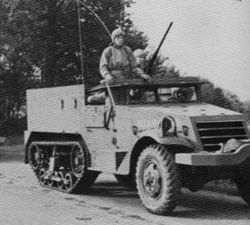
The M2 half-track car is an armored half-track produced by the United States during World War II. Its design drew upon half-tracks imported from France in the 1930s, employing standard components supplied by U.S. truck manufacturers to speed production and reduce costs. The concept was designed, and the pilot models manufactured by the Firestone Tire and Rubber Company Production by the White Motor Company began in 1940 and was expanded to include Autocar.
The M4 Sherman tank was produced in several variants and it was also the basis for a number of related vehicles. In addition, Shermans have been modified by several nations from modernization upgrades to complete hull conversions for another task.

The BA-3 was a heavy armored car developed in the Soviet Union in 1933, followed by a slightly changed model BA-6 in 1936. Both were based mostly on BA-I, the most important development being the new turret, same as in the T-26 m 1933 and BT-5 tanks, and also equipped with the 45 mm main gun. Around 180 BA-3 cars were built at the Izhorskij and Vyksunskij factories, until production ended in 1935. BA-6 followed with 386 cars produced between 1936 and 1938 in Izhorskij factory. Most of BA-3 production was based on the Ford-Timken chassis, a 6×4 modification of the US Ford AA 4×2 truck, but the last batch was built on Russian version of the same chassis - GAZ-AAA, continued to be used in BA-6. The biggest limitation of the BA-3 was the mobility, limited to roads or very hard ground, the result of unnecessarily large weight. The innovation that slightly improved mobility were the auxiliary ("Overall") tracks that could be fitted onto the rear tandem wheels, converting the car to half-track.

The 155 mm Gun Motor Carriage M12 was a U.S. self-propelled gun developed during the Second World War. It mounted a 155 mm gun derived from the French Canon de 155mm GPF field gun.

An artillery tractor, also referred to as a gun tractor, is a specialized heavy-duty form of tractor unit used to tow artillery pieces of varying weights and calibres. It may be wheeled, tracked, or half-tracked.

The 3-inch gun M1918 was a United States 3-inch anti-aircraft gun that entered service in 1918 and served until it was finally superseded by the 3-inch anti-aircraft gun M3 in 1930. The M3 was subsequently replaced by the M1 90mm AA gun just prior to the opening of World War II. The M3 3" gun was later adapted for the anti-tank role, serving as the main armament of the M10 tank destroyer during World War II.

The Austin Armoured Car was a British armoured car produced during the First World War. The vehicle is best known for its employment by the Imperial Russian Army in the First World War and by different forces in the Russian Civil War.
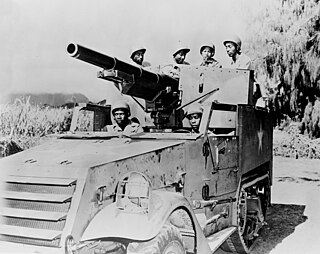
The M3 Gun Motor Carriage (GMC) was a United States Army tank destroyer equipped with one 75 mm gun and produced by Autocar. After the fall of France, the U.S. Army decided to make a self-propelled artillery piece from the M1897A4 gun on the M3 chassis, which was designated the T12. After some improvement, it came into production as the M3 Gun Motor Carriage. However, the supply of M2A3 gun shields was insufficient for production needs, so a new gun shield was used. This was designated the M3A1 GMC.

The Canon de 155 Grande Puissance Filloux (GPF) mle.1917 was a WWI-era French-designed 155 mm gun used by the French Army and the United States Army during the first half of the 20th century in towed and self-propelled mountings.

The Dodge WC series was a prolific range of light 4WD and medium 6WD military utility trucks, produced by Dodge / Fargo during World War II. Together with the 1⁄4-ton jeeps produced by Willys and Ford, the Dodge 1⁄2-tons and 3⁄4-tons made up nearly all of the light 4WD trucks supplied to the U.S. military in WWII – with Dodge contributing some 337,500 4WD units – over half as many of these as the jeep. Contrary to the versatility of the highly standardized jeep, which was mostly achieved through field modification, the Dodge WC-series came in many different, purpose-built, but mechanically uniform variants from the factory, much akin to the later family of High Mobility Multipurpose Wheeled Vehicles. The WC series evolved out of, and was part of a more extended family of trucks, with great mechanical parts commonality, that included open- and closed-cab cargo trucks and weapons carriers, (radio) command cars, reconnaissance vehicles, ambulances, carryalls, panel vans, and telephone installation and mobile emergency / field workshop trucks.

The 75 mm Gun M1916 was a US Army field artillery piece used during and after World War I. It was used as an anti-aircraft gun as well as a field piece. It originated as the 3-inch Gun M1913, which was soon modified to the 3-inch Gun M1916, which was later altered to the subject weapon.

The M16 Multiple Gun Motor Carriage, also known as the M16 Half-track, was an American self-propelled anti-aircraft weapon built during World War II. It was equipped with four 0.5 inch (12.7 mm) M2 Browning machine guns in a M45 Quadmount. 2700 were produced by White Motor Company from May 1943 to March 1944, with 568 M13 MGMCs and 109 T10 Half-tracks being converted into M16s as well.




